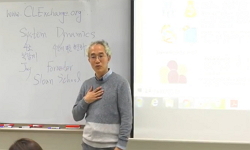이 연구는 창의적인 인재양성을 위해 시스템 사고를 통한 청소년의 창의성 계발 방안 및 효과를 제시하고자 한다. 이와 같은 관점에서 이 연구의 목적은 청소년기 학생들의 창의성을 증진하...
http://chineseinput.net/에서 pinyin(병음)방식으로 중국어를 변환할 수 있습니다.
변환된 중국어를 복사하여 사용하시면 됩니다.
- 中文 을 입력하시려면 zhongwen을 입력하시고 space를누르시면됩니다.
- 北京 을 입력하시려면 beijing을 입력하시고 space를 누르시면 됩니다.
창의성 개발을 위한 시스템 사고
한글로보기https://www.riss.kr/link?id=G3619223
- 저자
-
발행기관
-
-
발행연도
2006년
-
작성언어
Korean
-
주제어
창의성 증진 ; 미래형 인재양성 ; 장기적·동태적·실제적 사고 ; 시스템 사고 ; 학습조직 ; 시스템 다이내믹스 모델링
-
자료형태
한국연구재단(NRF)
-
0
상세조회 -
0
다운로드
부가정보
국문 초록 (Abstract)
문헌조사 결과를 바탕으로 청소년들에게 시스템 사고를 소개하고 설명하기 위한 교육용 교재를 개발하였다. 교육교재를 활용하여 실제로 중학교에서 수업을 실시해 보았으며, 이러한 교육 프로그램이 실제로 청소년들의 사고의 폭과 깊이를 확장시켜주는지를 검증해 보았다. 실증분석 결과에 의하면, 시스템 사고의 학습은 청소년들의 사고를 확장시키며, 인과관계를 고려한 논리적 사고에 도움을 주는 것으로 나타났다. 본 연구결과를 일반화하고 교육 효과를 극대화하기 위해서는 교육용 교재를 보완하는 동시에, 보다 다양한 청소년들을 대상으로 교육 프로그램을 실시해볼 필요가 있다.
이 연구는 창의적인 인재양성을 위해 시스템 사고를 통한 청소년의 창의성 계발 방안 및 효과를 제시하고자 한다. 이와 같은 관점에서 이 연구의 목적은 청소년기 학생들의 창의성을 증진하기 위한 방안으로써 시스템 사고의 활용가능성을 탐색하는 것이다. 연구를 원활히 추진하기 위하여 문헌조사, 현장교육, 설문조사 등을 수행하였다.
문헌조사 결과를 바탕으로 청소년들에게 시스템 사고를 소개하고 설명하기 위한 교육용 교재를 개발하였다. 교육교재를 활용하여 실제로 중학교에서 수업을 실시해 보았으며, 이러한 교육 프로그램이 실제로 청소년들의 사고의 폭과 깊이를 확장시켜주는지를 검증해 보았다. 실증분석 결과에 의하면, 시스템 사고의 학습은 청소년들의 사고를 확장시키며, 인과관계를 고려한 논리적 사고에 도움을 주는 것으로 나타났다. 본 연구결과를 일반화하고 교육 효과를 극대화하기 위해서는 교육용 교재를 보완하는 동시에, 보다 다양한 청소년들을 대상으로 교육 프로그램을 실시해볼 필요가 있다.
다국어 초록 (Multilingual Abstract)
The Chapter 1 discusses the backgrounds and methods of the study. This chapter also briefly introduces the limitation of traditional mental model and the necessity of systems thinking. The Chapter 2 reviews general theories on systems thinking and system dynamics. It also examines relationship between systems thinking and creativity. The Chapter 3 presents the procedures and means of analysis for achieving our research purpose. We used various research methods such as literature review, field survey, and research experiment. Based on the literature review, a teaching material was developed to introduce systems thinking to young students. Utilizing the teaching material, a experimental teaching was conducted in the secondary school and evaluated the effects of education. In chapter 4, we verified whether young students were really developed their thinking ability by this kind of education program. As it is difficult to measure the level of thinking ability qualitatively, we compared with the mean value of variables threat students wrote about the subject in writing test and mind-mapping test. We found that there were statistical differences between before and after conducting the education program. Most students suggested more variables after attending the program and it had statistical significance. The Second test has been done to check whether students really understood the contents of the program. According to the test results, most students understood the basic concept of the systems thinking. At the third test which measured the satisfaction level of education program, many students responded positively about the education program. Especially, they presented the highest satisfaction about the preparation and the attitude of teaching during their attending the education program. In the concluding chapter, the major findings were reviewed and the expectations of this study were presented. The result of this study can be used to develop teaching materials and guidelines for systems thinking.
Although this study has significant meaning on how systems thinking improve students' thinking abilities, it also has some limitations. For instance, it analyzed only three secondary schools in GyeongGi province. In addition, two schools extracted their samples among some excellent students. Thus, further research is necessary to complement the teaching material and to verify whether systems thinking influence on the creativity of young students or not.
This study started from the recognition that we can improve the ability of problem solving by learning systems thinking. In this regards, this study aims at analyzing the effect learning systems thinking in developing creativity. Main contents of this...
This study started from the recognition that we can improve the ability of problem solving by learning systems thinking. In this regards, this study aims at analyzing the effect learning systems thinking in developing creativity. Main contents of this research are as follows.
The Chapter 1 discusses the backgrounds and methods of the study. This chapter also briefly introduces the limitation of traditional mental model and the necessity of systems thinking. The Chapter 2 reviews general theories on systems thinking and system dynamics. It also examines relationship between systems thinking and creativity. The Chapter 3 presents the procedures and means of analysis for achieving our research purpose. We used various research methods such as literature review, field survey, and research experiment. Based on the literature review, a teaching material was developed to introduce systems thinking to young students. Utilizing the teaching material, a experimental teaching was conducted in the secondary school and evaluated the effects of education. In chapter 4, we verified whether young students were really developed their thinking ability by this kind of education program. As it is difficult to measure the level of thinking ability qualitatively, we compared with the mean value of variables threat students wrote about the subject in writing test and mind-mapping test. We found that there were statistical differences between before and after conducting the education program. Most students suggested more variables after attending the program and it had statistical significance. The Second test has been done to check whether students really understood the contents of the program. According to the test results, most students understood the basic concept of the systems thinking. At the third test which measured the satisfaction level of education program, many students responded positively about the education program. Especially, they presented the highest satisfaction about the preparation and the attitude of teaching during their attending the education program. In the concluding chapter, the major findings were reviewed and the expectations of this study were presented. The result of this study can be used to develop teaching materials and guidelines for systems thinking.
Although this study has significant meaning on how systems thinking improve students' thinking abilities, it also has some limitations. For instance, it analyzed only three secondary schools in GyeongGi province. In addition, two schools extracted their samples among some excellent students. Thus, further research is necessary to complement the teaching material and to verify whether systems thinking influence on the creativity of young students or not.











